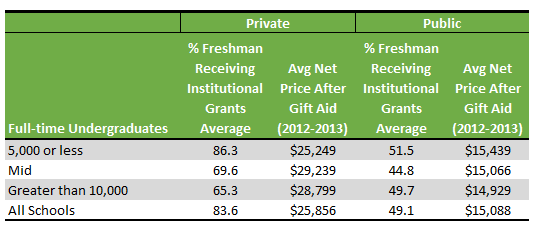 I started off this series of How to Pay Less for College by discussing how the economics of supply and demand are the basis for cutting the cost of college. The next two posts on college rankings and geography were basically explaining two significant elements that affect how much families will pay for college. Today I want to talk about a third factor that falls under the supply and demand of college admissions: college size.
I started off this series of How to Pay Less for College by discussing how the economics of supply and demand are the basis for cutting the cost of college. The next two posts on college rankings and geography were basically explaining two significant elements that affect how much families will pay for college. Today I want to talk about a third factor that falls under the supply and demand of college admissions: college size.
There are some pretty common stereotypes about college size, both good and bad. Small colleges provide personal attention but you’ll be limited in opportunities and everyone will know your business. Large colleges and universities provide plenty of academic opportunities, a diverse student population along with name recognition and career networking opportunities but it’s easy for students to get lost in the system.
Maybe because of these perceptions, high school students seem to prefer Goldilocks colleges–not too big, not too small, but just right. While there isn’t any official definition, I’m going to put the Goldilocks size at more than 5,000 but less than 10,000. This makes it bigger than the students’ high schools but under 10,000 so it doesn’t sound overwhelming.
Without going into the specifics of which size schools produce a better education, there’s a problem with the Goldilocks preference. It eliminates the vast majority of schools from consideration. I’ve discusses this before, approximately three-quarters of all four-year colleges have less than 5,000 undergraduates.
If you only consider Goldilocks colleges that have a 50% or better graduation rate (4-year for private, 5-year for public), you won’t find any in 15 states. Another 12 states only have 1 and 7 states only have 2. This means that in terms of supply, there is probably a shortage of Goldilocks schools and if you understand the economics of supply and demand, you know what this means. Goldilocks size colleges aren’t as likely to provide generous merit aid compared to other size schools.
According to the Integrated Postsecondary Education Data System (IPEDS), among private colleges with a 50% or better graduation rate, Goldilocks schools have the highest average net price. Colleges with 5,000 or fewer undergraduates had the lowest average net price. They also had the highest percentage of freshman receiving institutional grants.
Colleges with 50% or Better Graduation Rate
 This size issue is made worse by the fact that of the colleges ranked in the top 50 of US News Best National Universities, 22 are Goldilocks size. I can’t say anything about cause and effect but among private colleges, 76% have graduation rates of 50% or better compared to only 37% for the smaller colleges and 56% for the larger schools.
This size issue is made worse by the fact that of the colleges ranked in the top 50 of US News Best National Universities, 22 are Goldilocks size. I can’t say anything about cause and effect but among private colleges, 76% have graduation rates of 50% or better compared to only 37% for the smaller colleges and 56% for the larger schools.
The problem is that the 76% is actually only 48 colleges while that 37% represents 316 colleges. Like I said, if you’re looking for how to pay less for college, this is about the numbers.
But what about the small college stereotypes? I offer the following observations for the those uncomfortable with the idea of a smaller school but are interested in the financial aid opportunities. It’s not meant to “prove” smaller colleges are better than larger universities.
- Just because a class isn’t listed in the course catalog doesn’t mean the material isn’t taught. There are plenty of opportunities for independent study with willing faculty. One of my son’s friends organized a seminar to study just the book On War with three other students and two faculty members.
- As for diversity, it’s relative. At smaller colleges, students are more likely to interact with students from different backgrounds simply because there aren’t that many students to interact with. At larger institutions, it’s easy to fall into a group of similar students and never have to move outside your social comfort zone.
- At small colleges without graduate students, the undergraduates get the opportunities usually only available to graduate students. My son was a TA for two of his history classes. And while the research facilities may not always match those of large universities, the research experience can be just as valuable.
- In general, there is going to be more competition at large universities for just about anything. Whether trying out for an athletic team, running for student government, or trying to become president of a student organization, students at larger universities have a more challenging task to get to the “top.” The fewer students at smaller colleges can make many of those positions more accessible.
- For those who are looking for Saturday afternoons watching their football team compete for the national championship, well, there are always trade-offs. My son spent four-years at Beloit College wearing his burnt orange Longhorn hoodies.
Ultimately, a small college may not be the right answer regardless of the financial considerations. But given how few high schools students actually have any experience with smaller schools, it’s unwise to eliminate them at the beginning of the college search.

12 thoughts on “How to Pay Less for College: Avoid Goldilocks Colleges”